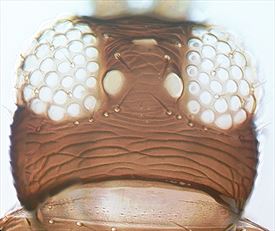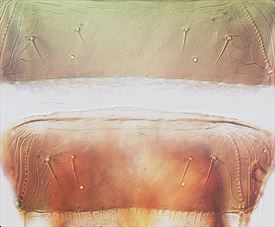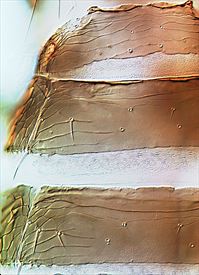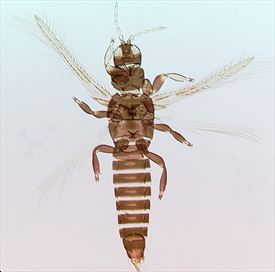
Antenna

Female


Pronotum

Meso & metanotum

Tergites VI-VII

Tergite II lateral margin

Female sternites IV-VII

Male
Distinguishing features
Both sexes fully winged. Female brown, tarsi and apices of fore tibiae yellow; antennal segments III–V mainly yellow, VI yellow in basal half; fore wings uniformly shaded. Antennae 7-segmented. Head with ocellar setae III arising outside triangle; postocular setae I twice as long as II & III. Pronotum with transverse markings on anterior half and about 20–24 discal setae. Mesonotum with widely spaced lines of sculpture, but no lines close to anterior campaniform sensilla. Metanotum with irregular longitudinal reticulate-striate sculpture, median setae arise close to anterior margin, campaniform sensilla absent. Fore wing first vein with 3 (or 4) setae on distal half, clavus with subterminal seta shorter than terminal seta. Abdominal tergite II with 3 lateral setae; tergite VIII comb complete but short and irregular. Sternites III–VII with 8–12 discal setae.
Male brown, sternites III–VII with broadly oval pore plate and about 4 discal setae posterolaterally.
Related species
There are 13 species of the genus Thrips recorded from New Zealand, out of a total of 280 species worldwide (Mound & Masumoto, 2005). Many of these species have the antennae clearly 7-segmented, whereas others have 8 segments. All members of Thrips genus have paired ctenidia on the tergites, and on tergite VIII these are postero-mesad to the spiracles, and they also lack ocellar setae pair I in front of the first ocellus. In contrast, Frankliniella species have ctenidia on tergite VIII antero-lateral to the spiracles, and a pair of setae is always present in front of the first ocellus. T. trehernei is closely related to T. physapus, the European type species of genus Thrips. These species are very similar in structure and sculpture, but the males of T. trehernei are brown whereas those of T. physapus are yellow. The record of T. physapus in New Zealand (Mound & Walker, 1982) was a misidentification of T. trehernei.
Biological data
Feeding and breeding in the flowers of the true Dandelion, Taraxacum vulgare [Asteraceae].
Distribution data
Recorded rarely in New Zealand (MC), but more common in southeastern Australia, and widespread in Europe and North America.
Family name
THRIPIDAE, THRIPINAE
Species name
Thrips trehernei Priesner
Original name and synonyms
Thrips trehernei Priesner, 1927: 356
Thrips magna Priesner, 1927: 355
Thrips taraxaci Moulton, 1936: 109
Thrips hukkineni Priesner, 1937: 108
References
Mound LA & Masumoto M (2005) The genus Thrips (Thysanoptera, Thripidae) in Australia, New Caledonia and New Zealand. Zootaxa 1020: 1–64
Mound LA, Tree DC, Paris D (2012) Oz Thrips – Thysanoptera in Australia. http://www.ozthrips.org/
Mound LA & Walker AK (1982) Terebrantia (Insecta: Thysanoptera). Fauna of New Zealand 1: 1–113.
zur Strassen R (2003) Die terebranten Thysanopteren Europas und des Mittelmeer-Gebietes. Die Tierwelt Deutschlands 74: 1–271.